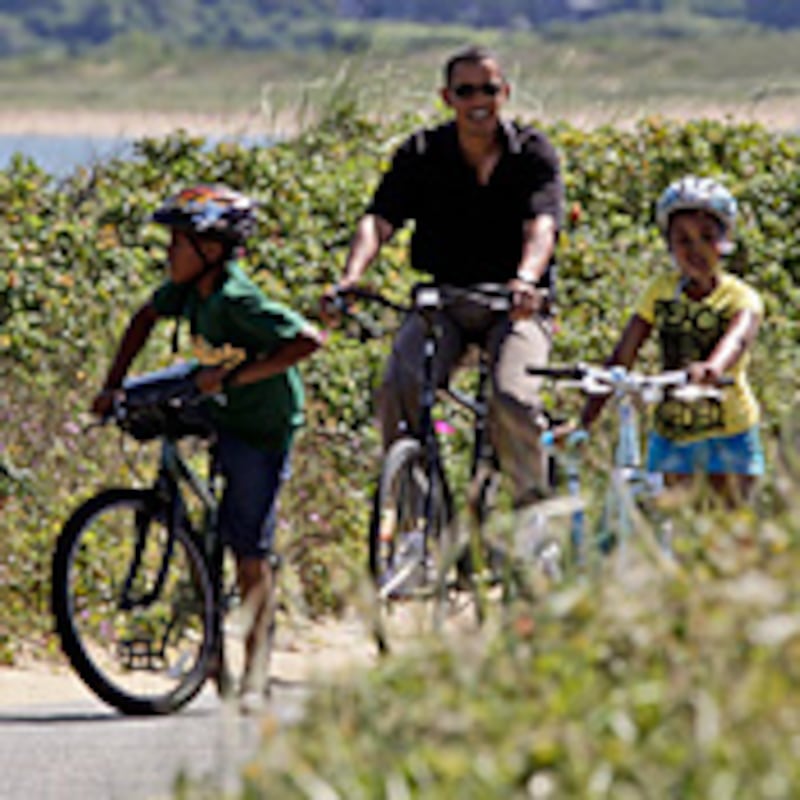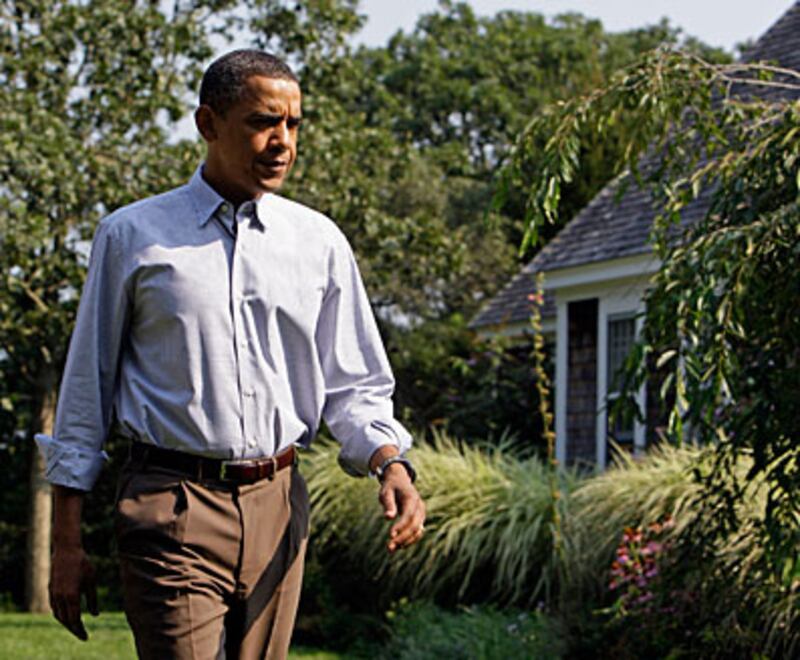
As Obama's holiday ends today, longtime summer resident Patricia Williams documents the upheaval his visit—and Sen. Kennedy's death—brought to the Vineyard.
Sunday, August 23
Till now, it has been a quiet summer on Martha’s Vineyard—fewer tourists than usual, much more rain than normal, so little sun that fruits have remained hard and small and vegetables have failed to ripen. All that changes the moment the president arrives. The sun breaks out. The ferry disgorges hordes of happy visitors. House rentals are hard to come by. Mopeds clog the little roads. The afternoon lull is broken by the heavy thwumping of military helicopters. People stand on their decks, turn their faces to the sky, and cheer.
Click Image Below to View Our Gallery of the Obamas on Vacation

Monday, August 24
He’s golfing! The neighborhood is a-twitter. A small crowd gathers round the entrance to Farm Neck Golf Course, cellphones and cameras held aloft. A solemn police officer gently pushes the pack to the far side of the street. Down the road, a woman stands on her lawn putting the finishing touches on an enormous OBAMA sign made entirely of red and white balloons. Up the road, the Portuguese-American Society puts out a sandwich board advertising their weekly “Fish Fry Friday,” but adding, “First Family Welcome.”
A man enters the Bunch of Grapes Bookstore and loudly, aggressively, grandstandingly, demands to know if “you have any books by Ann Coulter. She’s a Republican. Do you people carry books by Republicans?” More quietly, Cindy Sheehan sails back and forth across the pond that the Obamas’ farm overlooks; she is protesting the very notion of a presidential vacation. Locals advise her to bring a pole to the enterprise, that the fishing is good over there. That night, I dream that Obama turns his weary face into his pillow and groans, “I just need a nap.”
Tuesday, August 25
Friends make dinner reservations at the Oyster Bar and Grille in Oak Bluffs. I drive up moments after the president and his entourage arrive at Sweet Life Restaurant, just next door. Circuit Avenue, the town’s main street, is blocked; the sidewalks, the side streets, the little surrounding parks are packed. I stash my car half a mile away, edge my way through to the front of the goggling crowds. I approach a police officer to ask how best to get to the Oyster Bar. He asks if I have a reservation. Yes, I say, and give him my name. He lifts the yellow police tape and ushers me across the street. I feel a small thrill of euphoria: it’s like getting past the velvet rope at some chic New York nightspot. I passed the test! I want to wave in modest condescension to the throngs pressed back behind me.
Our party is well-seated right by the window. We spend the entire meal with our noses pressed to it. The only time we turn our heads is when the chocolate-truffle mud cake arrives. It is at that precise moment the presidential party exits Sweet Life and is hustled into a large, black tank of a car. All we get to see are the tail lights of the president's SUV as he pulls away. After the police tape is taken down, hundreds and hundreds of people pour into the street, comparing photographs and stories. Circuit Avenue turns into a jubilant street party.
I meet a college classmate who was seated in Sweet Life only a few feet away from the president. We press around her for a firsthand account. She says that the president had steak, the first lady had halibut. Valerie Jarrett wore her hair combed straight back, “very beach-y,” and sported a fashionable pair of little heels. The president’s sister was there with her baby; Malia and Sasha were not. Another friend claims to have taken a good, clear picture of the Obamas with her iPhone, but when she tries to summon it, there is only a blank screen with a blurry spot of light, like all those purported sightings of Jesus Christ and the Virgin Mary. The stores stay open late. We, the people, eat lots of ice cream and dance in the streets.
Wednesday, August 26
I wake up to the news that Senator Ted Kennedy has died. I am taken by surprise; I am heartbroken. I'd been in denial about this last of the Kennedy brothers. I'd been so irrationally certain of merciful miracles; he was supposed to live forever. The railing of August cicadas rises shrill and unbearable. My head throbs. It is a vivid green morning. The air is muggy and sad. It is 10 years ago this summer that John Kennedy, Jr.’s body was pulled from the sea off the coast of this island, his ashes returned days later. I feel a commingled grief; so much promise lost, the end of a legacy.
Flags fly at half staff. The cardboard signs welcoming Obama to the island are amended to include messages of condolence to the Kennedy family, as well as defiant messages of support for universal health care. President Obama expresses his sorrow with a short but eloquent statement that renders the island’s media center (otherwise known as the auditorium of the Oak Bluffs Elementary School) a steroidal hive of international satellite activity. Later in the day, he is spotted biking along the beach. The fact that his daughters wear helmets but he does not gives rise to some leisurely tsk-tsk-ing. A hand-painted sign by the side of the road welcomes—then warns—the first family to check their bodies for the Lyme-disease-bearing ticks that abound on the Vineyard. Life feels very fragile.
Thursday, August 27
I travel into Boston for the day. Traffic comes to a standstill as the funeral cortege accompanying Senator Kennedy’s body leaves the family compound in Hyannis Port around noon, winds its way up Route 3, and on through downtown Boston, followed by limousines transporting 85 of his closest relatives. The cortege travels past the Lt. Joseph P. Kennedy, Jr. Memorial School, past the Kennedy Federal Building, past the Rose Fitzgerald Kennedy Greenway (which is built over the old John F. Fitzgerald Expressway), past a landscape rich with the landmarks of intergenerational public service. It is an arresting event, an amazing grace, the miles upon miles of gathered mourners, the miles upon miles of tears and applause. The senator’s family members open the windows of their cars, waving back their gratitude and acknowledgement.
Friday, August 28
Senator Kennedy’s body lies in state at the Kennedy Presidential Library in South Boston. Tens of thousands line up to pay their respects as Hurricane Danny moves slowly up the Atlantic seaboard and darkens the sky.
Back on the Vineyard, there are gatherings at many of the local churches. The Kennedys are much loved on this island, and perhaps nowhere more so than among the African-American summer population. Senator Kennedy’s early endorsement of Barack Obama’s candidacy for the presidency meant a great deal. And just as Mayor John Fitzgerald, the senator’s maternal grandfather, was Boston’s first Irish-Catholic mayor, and just as the senator’s brother was our nation’s first Irish-Catholic president—so many African-Americans think of Barack Obama not merely as the first black president, but as “our Kennedy.”
Saturday, August 29
On what would have been the last full day of his vacation, President Obama fulfills the sad task of travelling to Our Lady of Perpetual Help Basilica in Boston to deliver the eulogy at Senator Kennedy’s funeral. Kennedy was “the soul of the Democratic Party,” he says. Offshore, Hurricane Danny is downgraded to a tropical storm but the wind whips ferociously at the welcome balloons and the hand-lettered signs. The Secret Service packs up in the driving rain. I log onto my computer to read the news of the day. It’s a very busy world out there. Somehow I doubt he got to take that nap.
Patricia J. Williams is the author of The Alchemy of Race and Rights; The Rooster's Egg; and Seeing a Color-Blind Future: The Paradox of Race. She is a also a columnist for The Nation.






